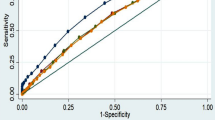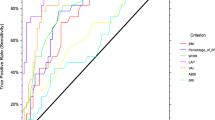Abstract
Background/objectives:
Optimal obesity indices in predicting cardio-metabolic risk are less studied in Asian. We evaluated optimal waist-to-height ratio (WHtR) for predicting hypertension, dyslipidemia and diabetes in Han and Uygur populations in Xinjiang, a northwest part of China.
Subjects/Methods:
This study involved 5603 Han and 4657 Uyghur participants. Anthropometric data, blood pressure, serum total cholesterol (TC), triglyceride, low-density lipoprotein, high-density lipoprotein and fasting glucose were determined. The cutoff values of WHtR were calculated; the relation between WHtR and prevalence of cardio-metabolic risks was evaluated.
Results:
There was a positive correlation between WHtR and blood pressure, TC, triglycerides and fasting glucose in both Han and Uygur participants (all P<0.001). The prevalence of hypertension, dyslipidemia and diabetes was higher with increased WHtR for both ethnic groups after adjusted by age. Calculated cutoff values of WHtR for predicting hypertension, dyslipidemia, diabetes or ⩾2 of these risk factors were 0.54 for both men and women in Han and 0.55 in male and 0.57 in female Uygur participants. A significant difference in blood pressure, triglycerides and fasting glucose between subgroups with WHtR either above or below the cutoff values was observed in both men and women of the two ethnicities.
Conclusions:
The optimal cutoff value of WHtR is a useful screen tool for predicting cardio-metabolic risks in Han and Uygur population in Xinjiang, northwest part of China.
This is a preview of subscription content, access via your institution
Access options
Subscribe to this journal
Receive 12 print issues and online access
$259.00 per year
only $21.58 per issue
Buy this article
- Purchase on Springer Link
- Instant access to full article PDF
Prices may be subject to local taxes which are calculated during checkout
Similar content being viewed by others
References
Zhang YX, Wang SR . Comparison of blood pressure levels among children and adolescents with different body mass index and waist circumference: study in a large sample in Shandong, China. Eur J Nutr 2014; 53: 627–634.
Khan A, Haq FU, Pervez MB, Saleheen D, Frossard PM, Ishaq M et al. Anthropometric correlates of blood pressure in normotensive Pakistani subjects. Int J Cardiol 2008; 124: 259–262.
Cai L, Liu A, Zhang Y, Wang P . Waist-to-height ratio and cardiovascular risk factors among Chinese adults in Beijing. PLoS One 2013; 8: e69298.
Ashwell M, Gunn P, Gibson S . Waist-to-height ratio is a better screening tool than waist circumference and BMI for adult cardiometabolic risk factors: systematic review and meta-analysis. Obes Rev 2012; 13: 275–286.
Dong X, Liu Y, Yang J, Sun Y, Chen L . Efficiency of anthropometric indicators of obesity for identifying cardiovascular risk factors in a Chinese population. Postgrad Med J 2011; 87: 251–256.
Vazquez G, Duval S, Jacobs DR Jr, Silventoinen K . Comparison of body mass index, waist circumference, and waist/hip ratio in predicting incident diabetes: a meta-analysis. Epidemiol Rev 2007; 29: 115–128.
Kodama S, Horikawa C, Fujihara K, Heianza Y, Hirasawa R, Yachi Y et al. Comparisons of the strength of associations with future type 2 diabetes risk among anthropometric obesity indicators, including waist-to-height ratio: a meta-analysis. Am J Epidemiol 2012; 176: 959–969.
Wakabayashi I . Stronger associations of obesity with prehypertension and hypertension in young women than in young men. J Hypertens 2012; 30: 1423–1429.
Aekplakorn W, Kosulwat V, Suriyawongpaisal P . Obesity indices and cardiovascular risk factors in Thai adults. Int J Obes (Lond) 2006; 30: 1782–1790.
Sung RY, So HK, Choi KC, Nelson EA, Li AM, Yin JA et al. Waist circumference and waist-to-height ratio of Hong Kong Chinese children. BMC Public Health 2008; 8: 324.
Tseng CH, Chong CK, Chan TT, Bai CH, You SL, Chiou HY et al. Optimal anthropometric factor cutoffs for hyperglycemia, hypertension and dyslipidemia for the Taiwanese population. Atherosclerosis 2010; 210: 585–589.
Browning LM, Hsieh SD, Ashwell M . A systematic review of waist-to-height ratio as a screening tool for the prediction of cardiovascular disease and diabetes: 0.5 could be a suitable global boundary value. Nutr Res Rev 2010; 23: 247–269.
Pan S, Yu ZX, Ma YT, Liu F, Yang YN, Ma X et al. Appropriate body mass index and waist circumference cutoffs for categorization of overweight and central adiposity among Uighur adults in Xinjiang. PLoS One 2013; 8: e80185.
Pan S, He CH, Ma YT, Yang YN, Ma X, Fu ZY et al. Serum uric acid levels are associated with high blood pressure in Chinese children and adolescents aged 10-15 years. J Hypertens 2014; 32: 998–1003.
Xie X, Ma YT, Yang YN, Fu ZY, Li XM, Huang D et al. Polymorphisms in the SAA1/2 gene are associated with carotid intima media thickness in healthy Han Chinese subjects: the Cardiovascular Risk Survey. PLoS One 2010; 5: e13997.
Xie X, Ma YT, Yang YN, Fu ZY, Li XM, Zheng YY et al. Polymorphisms in the SAA1 gene are associated with ankle-to-brachial index in Han Chinese healthy subjects. Blood Press 2011; 20: 232–238.
Hypertension A S o. Recommendations for routine blood pressure measurement by indirect cuff sphygmomanometry. American Society of Hypertension. Am J Hypertens 1992; 5: 207–209.
Joint Committee for Developing Chinese guidelines on Prevention and Treatment of Dyslipidemia in Adults. Chinese guidelines on prevention and treatment of dyslipidemia in adults. Zhonghua Xin Xue Guan Bing Za Zhi 2007; 35: 390–419.
Lara-Esqueda A, Aguilar-Salinas CA, Velazquez-Monroy O, Gomez-Perez FJ, Rosas-Peralta M, Mehta R et al. The body mass index is a less-sensitive tool for detecting cases with obesity-associated co-morbidities in short stature subjects. Int J Obes Relat Metab Disord 2004; 28: 1443–1450.
Fuchs FD, Gus M, Moreira LB, Moraes RS, Wiehe M, Pereira GM et al. Anthropometric indices and the incidence of hypertension: a comparative analysis. Obes Res 2005; 13: 1515–1517.
Tseng CH . Body composition as a risk factor for coronary artery disease in Chinese type 2 diabetic patients in Taiwan. Circ J 2003; 67: 479–484.
Despres JP, Lemieux I . Abdominal obesity and metabolic syndrome. Nature 2006; 444: 881–887.
Savva SC, Tornaritis M, Savva ME, Kourides Y, Panagi A, Silikiotou N et al. Waist circumference and waist-to-height ratio are better predictors of cardiovascular disease risk factors in children than body mass index. Int J Obes Relat Metab Disord 2000; 24: 1453–1458.
Lofgren I, Herron K, Zern T, West K, Patalay M, Shachter NS et al. Waist circumference is a better predictor than body mass index of coronary heart disease risk in overweight premenopausal women. J Nutr 2004; 134: 1071–1076.
Carson JA . Pocket tape measure for waist circumference: training medical students and residents on a simple assessment of body composition. J Nutr 2003; 133: 547S–549S.
Lopez-Alvarenga JC, Montesinos-Cabrera RA, Velazquez-Alva C, Gonzalez-Barranco J . Short stature is related to high body fat composition despite body mass index in a Mexican population. Arch Med Res 2003; 34: 137–140.
McCarthy HD, Ashwell M . A study of central fatness using waist-to-height ratios in UK children and adolescents over two decades supports the simple message– 'keep your waist circumference to less than half your height'. Int J Obes (Lond) 2006; 30: 988–992.
Garnett SP, Baur LA, Cowell CT . Waist-to-height ratio: a simple option for determining excess central adiposity in young people. Int J Obes (Lond) 2008; 32: 1028–1030.
Talaei M, Sadeghi M, Marshall T, Thomas GN, Iranipour R, Nazarat N et al. Anthropometric indices predicting incident type 2 diabetes in an Iranian population: The Isfahan Cohort Study. Diabetes Metab 2013; 39: 424–431.
Flegal KM, Carroll MD, Ogden CL, Johnson CL . Prevalence and trends in obesity among US adults, 1999-2000. JAMA 2002; 288: 1723–1727.
Lavie CJ, Milani RV . Obesity and cardiovascular disease: the hippocrates paradox? J Am Coll Cardiol 2003; 42: 677–679.
Manson JE, Bassuk SS . Obesity in the United States: a fresh look at its high toll. JAMA 2003; 289: 229–230.
Liang H, Chen X, Chen Q, Wang Y, Wu X, Li Y et al. The metabolic syndrome among postmenopausal women in rural canton: prevalence, associated factors, and the optimal obesity and atherogenic indices. PLoS One 2013; 8: e74121.
Yang YN, Xie X, Ma YT, Li XM, Fu ZY, Ma X et al. Type 2 diabetes in Xinjiang Uygur autonomous region, China. PLoS One 2012; 7: e35270.
Acknowledgements
We wish to express our sincere appreciation to the study participants and our colleagues in the Xinjiang Key Laboratory of Cardiovascular Disease for completing the survey for this study. This work was supported by grants from The Science and Technology Planning Project of Xinjiang Uygur Autonomous Region, China (No. 201233138).
Author information
Authors and Affiliations
Corresponding author
Ethics declarations
Competing interests
The authors declare no conflict of interest.
Additional information
Supplementary Information accompanies this paper on European Journal of Clinical Nutrition website
Supplementary information
Rights and permissions
About this article
Cite this article
He, CH., Pan, S., Ma, YT. et al. Optimal waist-to-height ratio cutoff values for predicting cardio-metabolic risk in Han and Uygur adults in northwest part of China. Eur J Clin Nutr 69, 954–960 (2015). https://doi.org/10.1038/ejcn.2015.25
Received:
Revised:
Accepted:
Published:
Issue Date:
DOI: https://doi.org/10.1038/ejcn.2015.25
This article is cited by
-
Optimum cutoff values of anthropometric indices of obesity for predicting hypertension: more than one decades of follow-up in an Iranian population
Journal of Human Hypertension (2018)
-
Association of metabolic syndrome with various anthropometric and atherogenic parameters in the Kazakh population in China
Lipids in Health and Disease (2016)



